2009.5. PEUGEOT 4007 open bonnet
[x] Cancel search: open bonnetPage 124 of 230
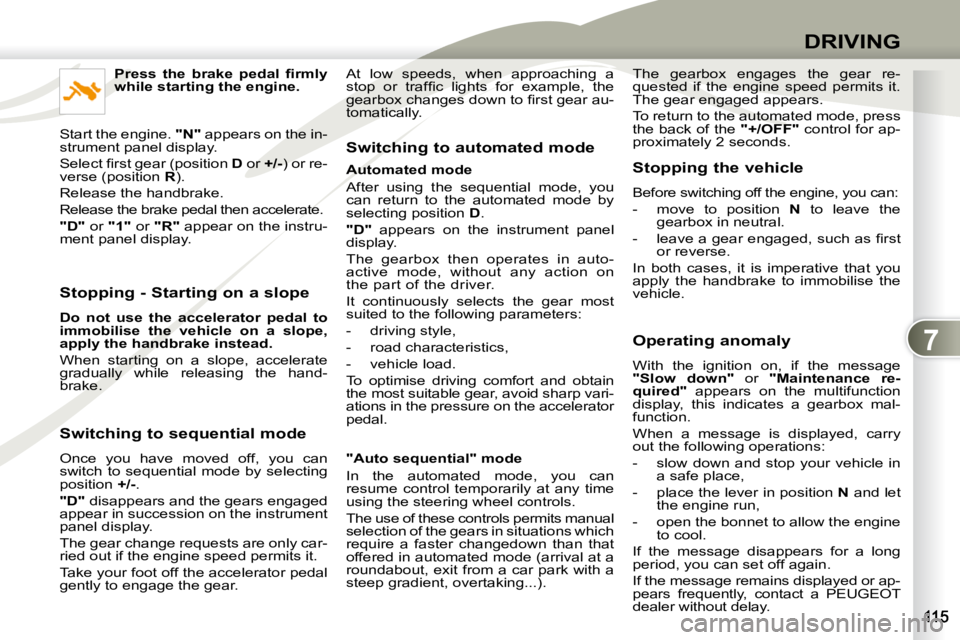
7
DRIVING
Stopping - Starting on a slope
Do not use the accelerator pedal to
immobilise the vehicle on a slope,
apply the handbrake instead.
When starting on a slope, accelerate
gradually while releasing the hand-
brake.
Switching to sequential mode
Once you have moved off, you can
switch to sequential mode by selecting
position +/- .
"D" disappears and the gears engaged
appear in succession on the instrument
panel display.
The gear change requests are only car-
ried out if the engine speed permits it.
Take your foot off the accelerator pedal
gently to engage the gear. Switching to automated mode
Automated mode
After using the sequential mode, you
can return to the automated mode by
selecting position
D .
"D" appears on the instrument panel
display.
The gearbox then operates in auto-
active mode, without any action on
the part of the driver.
It continuously selects the gear most
suited to the following parameters:
- driving style,
- road characteristics,
- vehicle load.
To optimise driving comfort and obtain
the most suitable gear, avoid sharp vari-
ations in the pressure on the accelerator
pedal.
"Auto sequential" mode
In the automated mode, you can
resume control temporarily at any time
using the steering wheel controls.
The use of these controls permits manual
selection of the gears in situations which
require a faster changedown than that
offered in automated mode (arrival at a
roundabout, exit from a car park with a
steep gradient, overtaking...). Stopping the vehicle
Before switching off the engine, you can:
- move to position
N to leave the
gearbox in neutral.
� � �-� � �l�e�a�v�e� �a� �g�e�a�r� �e�n�g�a�g�e�d�,� �s�u�c�h� �a�s� �fi� �r�s�t� or reverse.
In both cases, it is imperative that you
apply the handbrake to immobilise the
vehicle.
Operating anomaly
With the ignition on, if the message
"Slow down" or "Maintenance re-
quired" appears on the multifunction
display, this indicates a gearbox mal-
function.
When a message is displayed, carry
out the following operations:
- slow down and stop your vehicle in a safe place,
- place the lever in position N and let
the engine run,
- open the bonnet to allow the engine to cool.
If the message disappears for a long
period, you can set off again.
If the message remains displayed or ap-
pears frequently, contact a PEUGEOT
dealer without delay.
�P�r�e�s�s� �t�h�e� �b�r�a�k�e� �p�e�d�a�l� �fi� �r�m�l�y�
while starting the engine.
Start the engine. "N" appears on the in-
strument panel display.
� �S�e�l�e�c�t� �fi� �r�s�t� �g�e�a�r� �(�p�o�s�i�t�i�o�n� � D or +/- ) or re-
verse (position R ).
Release the handbrake.
Release the brake pedal then accelerate.
"D" or "1" or "R" appear on the instru-
ment panel display. The gearbox engages the gear re-
quested if the engine speed permits it.
The gear engaged appears.
To return to the automated mode, press
the back of the
"+/OFF" control for ap-
proximately 2 seconds.
At low speeds, when approaching a
�s�t�o�p� �o�r� �t�r�a�f�fi� �c� �l�i�g�h�t�s� �f�o�r� �e�x�a�m�p�l�e�,� �t�h�e�
�g�e�a�r�b�o�x� �c�h�a�n�g�e�s� �d�o�w�n� �t�o� �fi� �r�s�t� �g�e�a�r� �a�u�-
tomatically.
Page 128 of 230
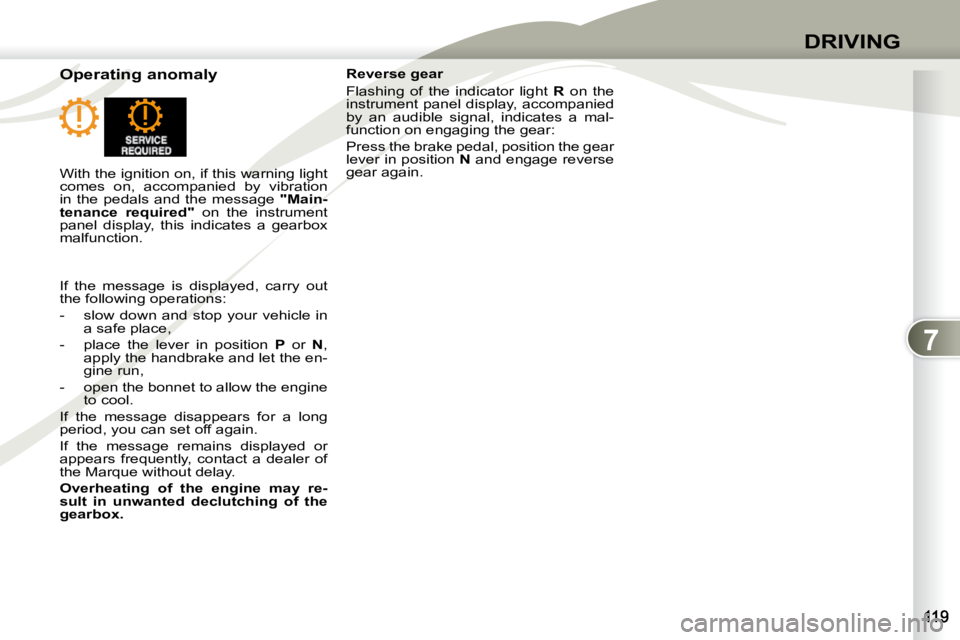
7
DRIVING
Operating anomaly Reverse gear
Flashing of the indicator light
R on the
instrument panel display, accompanied
by an audible signal, indicates a mal-
function on engaging the gear:
Press the brake pedal, position the gear
lever in position N and engage reverse
gear again.
With the ignition on, if this warning light
comes on, accompanied by vibration
in the pedals and the message "Main-
tenance required" on the instrument
panel display, this indicates a gearbox
malfunction.
If the message is displayed, carry out
the following operations:
- slow down and stop your vehicle in a safe place,
- place the lever in position P or N ,
apply the handbrake and let the en-
gine run,
- open the bonnet to allow the engine to cool.
If the message disappears for a long
period, you can set off again.
If the message remains displayed or
appears frequently, contact a dealer of
the Marque without delay.
Overheating of the engine may re-
sult in unwanted declutching of the
gearbox.
Page 136 of 230
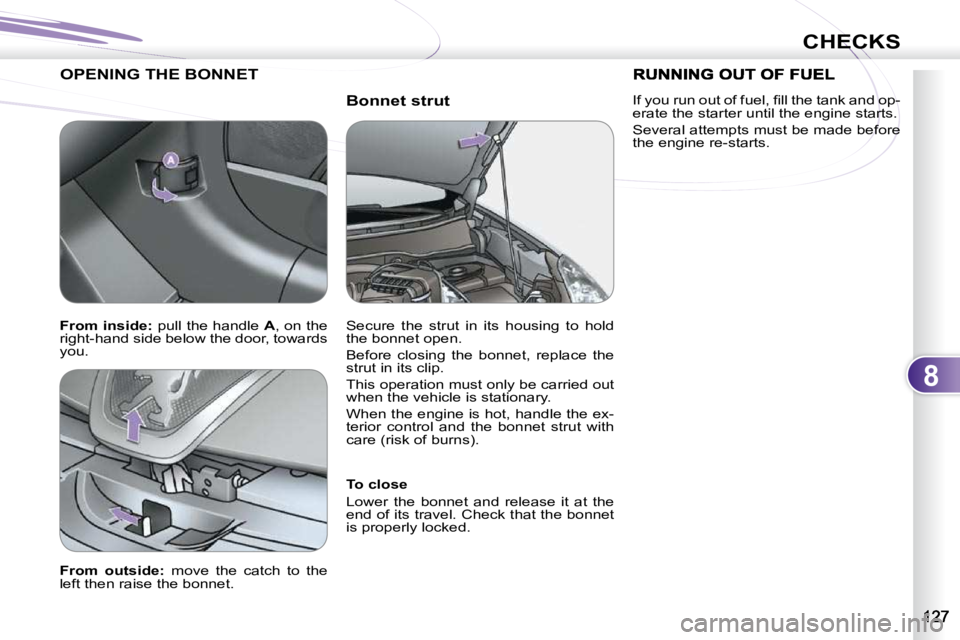
8
CHECKS
Bonnet strut
OPENING THE BONNET
To close
Lower the bonnet and release it at the
end of its travel. Check that the bonnet
is properly locked.
From outside: move the catch to the
left then raise the bonnet. Secure the strut in its housing to hold
the bonnet open.
Before closing the bonnet, replace the
strut in its clip.
This operation must only be carried out
when the vehicle is stationary.
When the engine is hot, handle the ex-
terior control and the bonnet strut with
care (risk of burns).
From inside: pull the handle A , on the
right-hand side below the door, towards
you. � � �I�f� �y�o�u� �r�u�n� �o�u�t� �o�f� �f�u�e�l�,� �fi� �l�l� �t�h�e� �t�a�n�k� �a�n�d� �o�p�-
erate the starter until the engine starts.
Several attempts must be made before
the engine re-starts.
Page 155 of 230
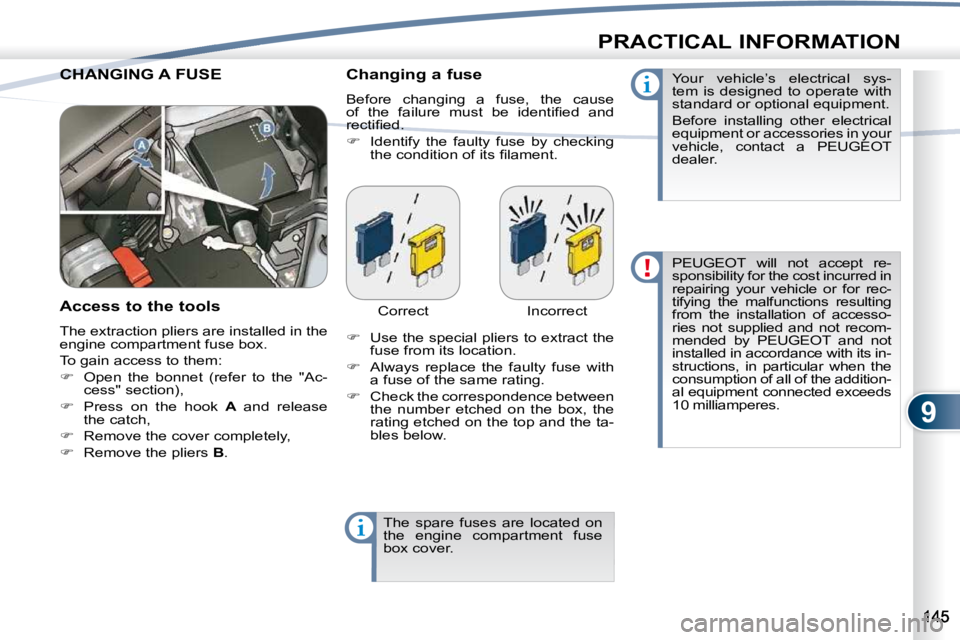
9
PRACTICAL INFORMATION
CHANGING A FUSE CHANGING Changing a fuse
Before changing a fuse, the cause
�o�f� �t�h�e� �f�a�i�l�u�r�e� �m�u�s�t� �b�e� �i�d�e�n�t�i�fi� �e�d� �a�n�d�
�r�e�c�t�i�fi� �e�d�.�
� Identify the faulty fuse by checking
�t�h�e� �c�o�n�d�i�t�i�o�n� �o�f� �i�t�s� �fi� �l�a�m�e�n�t�.� �
Access to the tools
� �T�h�e� �e�x�t�r�a�c�t�i�o�n� �p�l�i�e�r�s� �a�r�e� �i�n�s�t�a�l�l�e�d� �i�n� �t�h�e�
�e�n�g�i�n�e� �c�o�m�p�a�r�t�m�e�n�t� �f�u�s�e� �b�o�x�.�
To gain access to them:
� Open the bonnet (refer to the "Ac-
cess" section),
� Press on the hook A and release
the catch,
� Remove the cover completely,
� Remove the pliers B . Correct Incorrect
� � � �U�s�e� �t�h�e� �s�p�e�c�i�a�l� �p�l�i�e�r�s� �t�o� �e�x�t�r�a�c�t� �t�h�e�
fuse from its location.
� Always replace the faulty fuse with
a fuse of the same rating.
� Check the correspondence between
�t�h�e� �n�u�m�b�e�r� �e�t�c�h�e�d� �o�n� �t�h�e� �b�o�x�,� �t�h�e�
rating etched on the top and the ta-
bles below.
The spare fuses are located on
the engine compartment fuse
�b�o�x� �c�o�v�e�r�.� Your vehicle’s electrical sys-
tem is designed to operate with
standard or optional equipment.
Before installing other electrical
equipment or accessories in your
vehicle, contact a PEUGEOT
dealer.
PEUGEOT will not accept re-
sponsibility for the cost incurred in
repairing your vehicle or for rec-
tifying the malfunctions resulting
from the installation of accesso-
ries not supplied and not recom-
mended by PEUGEOT and not
installed in accordance with its in-
structions, in particular when the
consumption of all of the addition-
�a�l� �e�q�u�i�p�m�e�n�t� �c�o�n�n�e�c�t�e�d� �e�x�c�e�e�d�s�
10 milliamperes.
Page 158 of 230

9
PRACTICAL INFORMATION
Engine compartment fuses
� �T�h�e� �f�u�s�e� �b�o�x� �i�s� �p�l�a�c�e�d� �i�n� �t�h�e� �e�n�g�i�n�e� �c�o�m�p�a�r�t�m�e�n�t� �n�e�a�r� �t�h�e�
battery (left-hand side).
Access to the fuses
� Open the bonnet (refer to the "Access" section),
� Press on the hook A to release the catch,
� Remove the cover completely,
� Change the fuse (refer to the corresponding paragraph).
� � � �W�h�e�n� �y�o�u� �h�a�v�e� �fi� �n�i�s�h�e�d�,� �c�l�o�s�e� �t�h�e� �c�o�v�e�r� �c�a�r�e�f�u�l�l�y� �t�o�
�g�u�a�r�a�n�t�e�e� �t�h�e� �s�e�a�l�i�n�g� �o�f� �t�h�e� �f�u�s�e� �b�o�x�.� �
Fuse N° Rating Functions
1 15 A Front fog lamps.
2 7 A 2.4 litre 16V engine control unit.
3 20 A � �C�V�T� �a�u�t�o�m�a�t�i�c� �g�e�a�r�b�o�x� �c�o�n�t�r�o�l� �u�n�i�t�,�
�C�V�T� �a�u�t�o�m�a�t�i�c� �g�e�a�r�b�o�x� �c�o�n�t�r�o�l� �r�e�l�a�y�.�
4 10 A Horn.
5 7.5 A 2.4 litre 16V alternator.
6 20 A Headlamp wash.
7 10 A Air conditioning.
8 15 A 2.4 litre 16V engine control unit.
9 - Not used.
10 15 A Demisting, wipers.
11 - Not used.
12 - Not used.
13 - Not used.
14 10 A Left-hand main beam headlamp.
15 10 A Right-hand main beam headlamp.
16 20 A � �L�e�f�t�-�h�a�n�d� �d�i�p�p�e�d� �h�e�a�d�l�a�m�p� �(�x�e�n�o�n�)�.�
17 20 A � �R�i�g�h�t�-�h�a�n�d� �d�i�p�p�e�d� �h�e�a�d�l�a�m�p� �(�x�e�n�o�n�)�.�
18 10 A Left-hand dipped headlamp, manual
and automatic headlamp adjustment.
19 10 A Right-hand dipped headlamp.
20 - Not used.
21 10 A Ignition coils.
Page 160 of 230
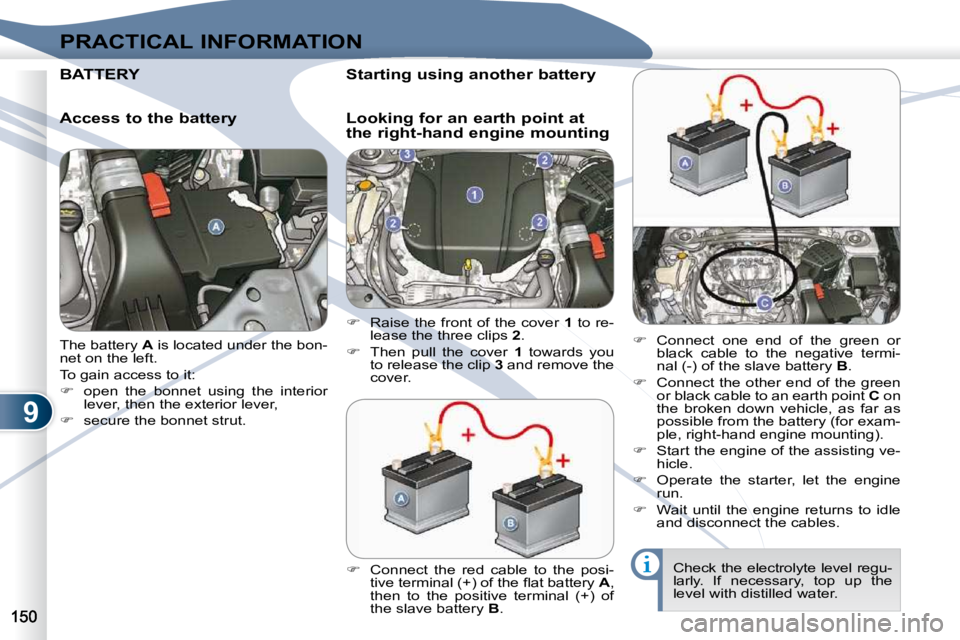
9
PRACTICAL INFORMATION
The battery A is located under the bon-
net on the left.
To gain access to it:
� open the bonnet using the interior
�l�e�v�e�r�,� �t�h�e�n� �t�h�e� �e�x�t�e�r�i�o�r� �l�e�v�e�r�,�
� secure the bonnet strut.
BATTER BATTERY
Access to the battery
� Connect the red cable to the posi-
�t�i�v�e� �t�e�r�m�i�n�a�l� �(�+�)� �o�f� �t�h�e� �fl� �a�t� �b�a�t�t�e�r�y� � A ,
then to the positive terminal (+) of
the slave battery B .
� Connect one end of the green or
black cable to the negative termi-
nal (-) of the slave battery B .
� Connect the other end of the green
or black cable to an earth point C on
the broken down vehicle, as far as
�p�o�s�s�i�b�l�e� �f�r�o�m� �t�h�e� �b�a�t�t�e�r�y� �(�f�o�r� �e�x�a�m�-
ple, right-hand engine mounting).
� Start the engine of the assisting ve-
hicle.
� Operate the starter, let the engine
run.
� Wait until the engine returns to idle
and disconnect the cables.
� Raise the front of the cover 1 to re-
lease the three clips 2 .
� Then pull the cover 1 towards you
to release the clip 3 and remove the
cover.
Check the electrolyte level regu-
larly. If necessary, top up the
level with distilled water.
Starting using another battery
Looking for an earth point at
the right-hand engine mounting